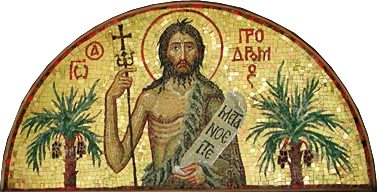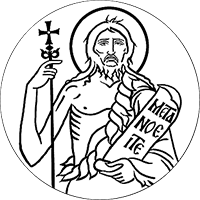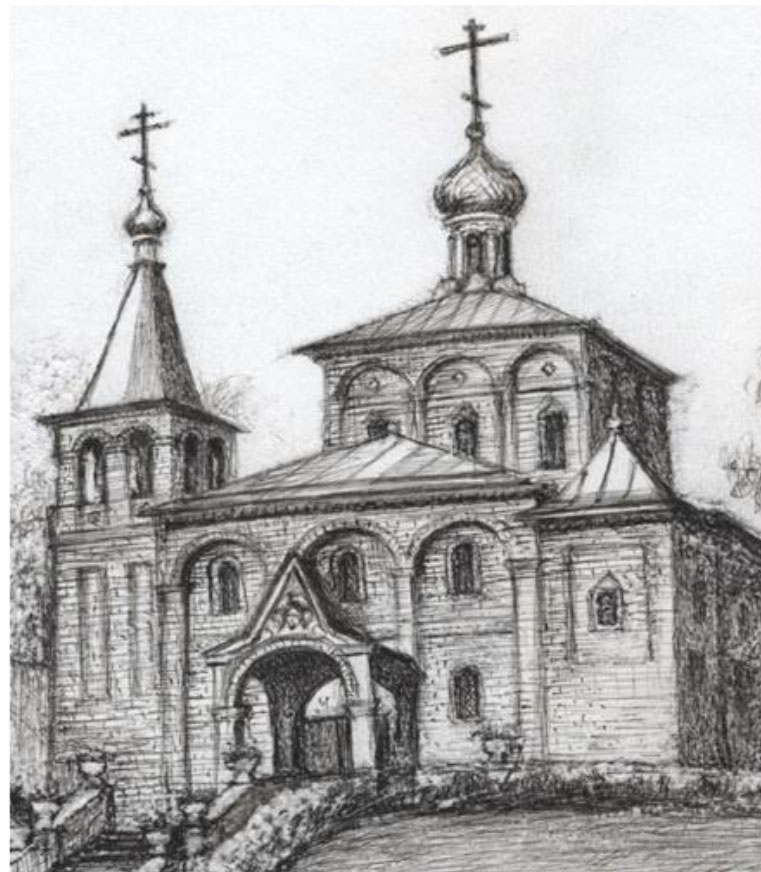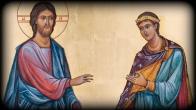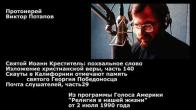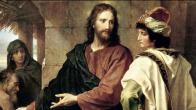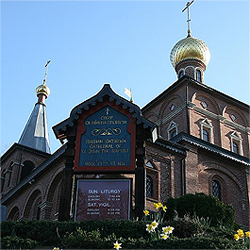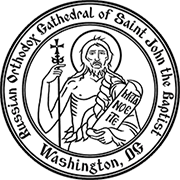You are here
Liturgy of the Presanctified Gifts, Fr. V.Potapov
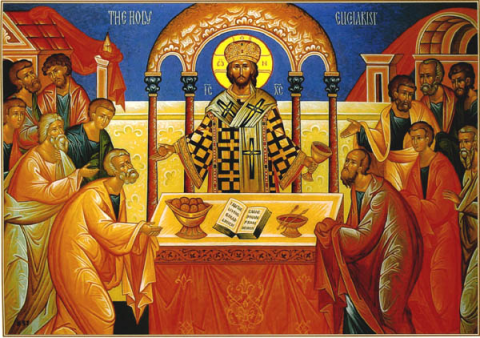
The Liturgy of the Presanctified Gifts may be characterized, without exaggeration, as the heart, the center of the services of Great Lent. In some ancient manuscripts of the service books, it is known as the “Liturgy of the Great Quadragesima.” In fact, it is the service which best typifies this sacred time of the year.
The essence of this service is revealed in its very name: it is the “Liturgy of Gifts Presanctified.” This distinguishes it from the liturgies of St. Basil the Great and of St. John Chrysostom, in which the Eucharist, the offering and sanctification of the Gifts, takes place. During the “Liturgy of the Great Quadragesima” we are offered the Holy Gifts “pre-sanctified,” i.e. already sanctified at a liturgy served on a previous day. These Holy Gifts are offered to us that we might have the opportunity to commune of them and be sanctified by them. In other words, the Liturgy of the Presanctified Gifts is essentially not a “liturgy” in the sense of the Liturgies of St. John Chrysostom or St. Basil the Great, but is rather a special rite of Communion.
In order to understand why a rite of Communion of pre-sanctified Holy Gifts came into being, one must consider its history. Its roots lie in the ancient practice of the Church. In the early centuries of Christian history, the faithful approached to receive the Holy Gifts at each Liturgy. It was even a practice among the faithful, when there was no weekday liturgy, that they would privately commune of Holy Gifts left over from the Sunday liturgy. On this foundation, a special rite of prayer crystallized within the monasteries: all of the monastics would pray together before Communion, and afterwards, together they would thank God, Who had enabled them to be Communicants of the Holy Mysteries. This would be done either after Vespers or after the Ninth Hour (about 3:00 PM). In time, this rule of prayer took on the form of a short service, somewhat similar to the rite of the Liturgy. Thus developed what we now call the “Order of the Typica,” in contemporary practice served after the Sixth and Ninth Hours. The very name “Typica” points to the fact that in some measure this short service typifies the Liturgy. It is in this sense a precursor to our Liturgy of the Presanctified Gifts.
During Great Lent, the full Divine Liturgy is served only on Saturdays and Sundays. Ancient church practice, confirmed in the canons of the Councils, forbids the serving of Liturgies on weekdays during Great Lent, inasmuch as those days are entirely dedicated to fasting and repentance. Service of the Divine Liturgy would be incompatible with the mournful character of such days. The Liturgy is a Paschal Mystery, a Feast of the Church, filled with joy and spiritual jubilation.
As St. Basil the Great states, the faithful of that time were used to receiving Communion not only on Saturdays and Sundays, but also at least twice during the week - on Wednesdays and Fridays. Therefore, the question arose: How could they commune outside the Liturgy? The answer had already been provided: they could commune of the Holy Gifts sanctified at one of the earlier Liturgies. In those days, fasting meant complete abstinence from food until sunset, and Communion of the Holy Gifts was the crown, the end, of the Lenten day. For this reason, on those weekdays, it took place after Vespers.
The rite of the Liturgy of the Presanctified Gifts consists of Vespers, at the conclusion of which the Holy, Presanctified Gifts are offered, and the prayers before Communion are read. Communion itself takes place, and is followed by prayers of thanksgiving. The service’s connection to Great Lent is reflected in its special “mournful” character. The Altar Table and sacred vessels containing the Holy Gifts are covered with dark-colored vestments. Prayers are read with a sense of humility and tenderness. Overall, the entire service is marked by a special sense of mystery.
The first part of the Liturgy of the Presanctified Gifts consists of Great Lenten Vespers, with some specific distinguishing features. The priest is vested in dark vestments. Vespers itself begins not with the usual “Blessed is our God,” but rather with the opening doxology of the Divine Liturgy: “Blessed is the Kingdom of the Father and of the Son and of the Holy Spirit…” In this manner, the entire service turns toward hope in the Kingdom, that same anticipation which characterizes all of Great Lent.
Then, as in other Vesper services, Psalm 103 is read. This “opening” psalm begins with the words “Bless the Lord, O my soul! O Lord my God, thou art greatly magnified…”
This psalm, which praises God, the creator of the whole world, is a sort of “preface” to Vespers, and with it the entire cycle of daily services, for according to Old Testament tradition, evening and the coming night are considered the beginning of the day.
After this “preface,” the deacon (or in the absence of a deacon, the priest himself) invites the faithful to communal prayer, in the Great Litany, the Litany of Peace, which begins with the words “In peace, let us pray to the Lord…”
Then Psalms 119 and 133 are read. These psalms form the 18th kathisma (chapter) of the Psalter, the book of psalms. The psalms are known as “hymns of ascent.” In Old Testament times, they were sung while one was ascending the steps of the Temple in Jerusalem.
While these psalms are being read on the kliros, in the Altar the priest prepares the Holy Gifts on the Table of Oblation. The Presanctified Lamb (the Body of Christ, permeated with His Most-precious Blood), which had been left on the Altar Table since the previous Sunday or Saturday, is transferred to the Table of Oblation. Then ordinary, unsanctified wine and water are poured into the Chalice, and the Holy Vessels are covered, as is done before a full Liturgy. All of this is performed in silence, with no accompanying prayers. The Order of Divine Service underscores that distinctive feature: all of the prayers have already been read at the Sunday Liturgy at which the Holy Gifts have been sanctified.
After this preparation and after the reading of the 18th kathisma, the evening service continues with the chanting of selections from the usual Vespers psalms - beginning with the words “Lord, I have cried unto Thee, hearken unto me…” The stichera for “Lord I have cried…” appointed in the service books for the given day are interspersed with the text of the psalms. Upon the conclusion of these chants, the clergy perform the usual Evening Entrance, the procession into the Altar through the Royal Doors, concluding with the prayer “O Gentle Light.”
Following the Evening Entrance, there are two readings (paremoi) from the Old Testament. One is from the Book of Genesis, and the other from the Book of Proverbs of Solomon. Between these two readings, a rite is performed which reminds us of the times when Great Lent was dedicated to preparing people for Holy Baptism. During the reading from the first Old Testament passage, the priest places a lighted candle upon the Gospels lying on the Altar Table. At the conclusion of the first reading, the priest takes this candle and a censer and blesses the faithful, with the words “The Light of Christ enlighteneth all!” The candle is a symbol of Christ, the Light of the world. The fact that the candle rests upon the Gospels during the reading of the Old Testament points to the fact that all prophecy was fulfilled in Christ, Who enlightened His disciples, that they “might understand the Scriptures.” The Old Testament leads to Christ, just as Great Lent leads to the enlightenment of those being baptized. The Light of Holy Baptism, uniting people to Christ, opens their minds to the understanding of Christ’s teachings.
After the second Old Testament reading, there emanates from the center of the church a moving and solemn chant: “Let my prayer be set forth as incense before Thee, the lifting up of my hands, as an evening sacrifice.” These words come from Psalms 140. During this chant, censing takes place before the Altar Table and before the Table of Oblation. The chant, with other verses from the same psalm interspersed, is repeated six times.
In Russian Church practice, following the reading of these verses, the Great Lenten prayer of St. Ephraim the Syrian, “O Lord and Master of my life…”, is read.
There follows fervent prayer for all members of the Church, and also for the catechumens. After Wednesday of the 4th week of Great Lent, these petitions are followed by a special litany for those catechumens who this year are preparing for “holy illumination,” i.e. for the Mystery of Holy Baptism. In ancient times, Holy Baptism was performed on Holy and Great Saturday. After all of the catechumens are dismissed, the second part of the Liturgy of the Presanctified Gifts, the rite of Holy Communion, begins.
The solemn moment of the transfer of the Holy Gifts to the Altar Table approaches. Outwardly, this Entrance resembles the Great Entrance at the Liturgy, but in essence and spiritual meaning it is, of course, quite different. In the full Eucharistic service, the Great Entrance is the transfer/offering of as-yet unsanctified Gifts. The Church offers itself, its life, the life of its members and all creation as a sacrifice to God, incorporating this sacrifice into the one perfect sacrifice of Christ. Remembering Christ, the Church remembers all those whom He has taken upon Himself for their redemption and salvation. The transfer of the Holy Gifts symbolically represents the appearance of Christ and the conclusion of fasting, prayer, and the anticipation, the approach, of that help, comfort, and joy which we have been awaiting.
The solemn transfer of the Holy Gifts from the Table of Oblation to the Holy Altar Table is accompanied by the ancient hymn “Now the Hosts of Heaven…” In English it is rendered: “Now the Hosts of Heaven invisibly worship with us; for behold the King of Glory enters in. Behold the accomplished mystical sacrifice is being escorted in. With faith and love let us draw nigh, that we may become partakers of life everlasting. Alleluia, alleluia, alleluia.”
The Entrance with the already-sanctified Holy Gifts is performed with extreme reverence and piety. During the Entrance, the faithful prostrate themselves upon the ground. According to the practice of the Russian Church, following the Great Entrance at the Liturgy of the Presanctified Gifts, the prayer of St. Ephraim of Syria, “O Lord and Master of my life…”, is read.
After that prayer is read, the immediate preparation for Holy Communion begins. Its essence lies in the Lord’s Prayer, in the “Our Father,” with which preparation for Holy Communion always concludes. In pronouncing Christ’s own prayer, we take unto ourselves the Spirit of Christ. We adopt as our own His prayer to the Father, His will, His desire, His life.
The Communion of the clergy takes place, and is followed by the Communion of the laity, during the singing of the verse “O taste and see, that the Lord is good!”
The Service ends, and the priest announces “Let us depart in peace!” At the conclusion of the Service, the Prayer before the Ambo is read. The concluding prayers at full Liturgies and at the Liturgy of the Presanctified Gifts are known as Prayers before the Ambo because the priest says them near the place where at one time there stood in the midst of the church the ancient “ambo,” i.e. a special stone cathedra, from which the Gospel was read.
“The Prayer before the Ambo” read at the Liturgy of the Presanctified Gifts is especially beautiful. It reflects the connection between the serving of the Liturgy of the Presanctified Gifts and the time of Great Lent. The Holy Quadregesima is a time of spiritual struggle, a time of difficult battle with the passions and with sins. Yet there is no doubt that victory over invisible enemies will be granted to all who, according to the words of the Prayer before the Ambo, struggle “to fight the good fight.” And the day of the Holy Resurrection already is at hand.
The Divine Liturgy of the Presanctified Gifts is one of the most marvelous and moving services of the Church. At the same time, it is an urgent call to frequent Communion of the Holy Gifts of Christ. In it we hear a voice from distant centuries, the voice of the living, ancient tradition of the Church. This voice says that a believer cannot live the life in Christ unless he constantly renews his connection with the fountain of life, by communing of the Body and Blood of our Lord Jesus Christ. For Christ is, according to the words of the Holy apostle Paul, “our life” (Colossians 3:4).
PARISH LIFE
RECENT VIDEOS
Address of our Cathedral
Subscribe to our mailing list
While all the materials on this site are copyrighted, you may use them freely as long as you treat them
with respect and provide attribution on the Russian Orthodox Cathedral of St.John the Baptist of Washington DC.
